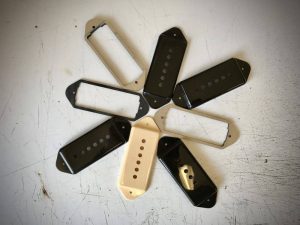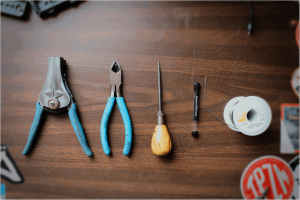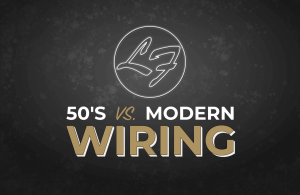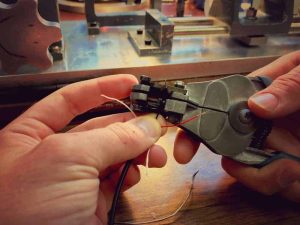
How To Choose The Right Humbucker Lead
There’s a lot you can do with a humbucker pickup, wiring wise. Choosing the right Humbucker Lead will help you get the job done right.
Humbuckers are a powerful tool in the guitar pickup toolbox. They have their own sound, and their own function: they don’t hum! (duh) They are also very versatile. You can wire them a plethora of ways, depending on what you’re trying to achieve. That said, how do you know which humbucker lead to choose so you get the options you want?
From the easiest installation to the most options, we are going to break down humbucker leads, so you can make informed decisions. Here we go:
Gibson® Braided Humbucker Lead:

The Gibson Braided Shielded Lead is an extremely popular type of humbucker lead. It features a metal braid around a cloth insulator.
Inside the cloth insulator, is a stranded lead, which is the “hot” signal of the pickup. The braided shield offers two features: durability and easy installation. The Braided Shield is actually the method of grounding the pickup. It’s usually soldered on the back of the volume pot that controls the pickup.
To Install:
- Solder the inside lead to the Volume Pot input.
- Solder the Braided Shield to the casing of the Volume Pot, and make sure it’s connected to ground.
With the ease of installation comes certain drawbacks: you can’t reverse the phase. If you were to buy a pickup with this lead and realize that it’s out of phase with your other pickup, you’re out of luck. You also can’t Split the humbucker – it’s all or nothing. That’s where multiple leads come in:
- Easy Installation
- Durable
- Not Splittable
- Not Reversible
- Only for Gibson-style instruments, not for Fender-style instruments.
2-Conductor Lead, With Shield

This is a beautiful lead, and we recommend it all the time. This lead has a White, Black, and Shield, all surrounded by a thick rubber insulator. This lead allows you to reverse the phase: the coil is completely separated from the chassis ground.
We recommend this lead if buying a single Hum Cancelling pickup, like our Hum Cancelling P90s, Hum Cancelling Jazzmaster, Alnico Noiseless P90s and more.
To Install:
- Solder the Shield to Ground
- White connects to Switch Input or Volume Pot Input
- Solder Black to Ground, with Shield
If you ever experienced phasing issues, you could simply swap Black and White, and you’ll be set.
- Easy Installation
- Phase-reversible, perfect for buying a single pickup
- Separate shield from the coil allows you to perform certain push-pull mods, like the 4-Way Tele mod.
- More labor required to strip leads
- Not as durable as Gibson Braided lead
3-Conductor, With Shield

When 2-Conductor isn’t available for a Humbucker, this will do the trick. It’s like the 2-Conductor Lead, except it has a Red lead, which allows you to Split the humbucker.
To Install:
- Solder the Shield to Ground
- White solders to Switch Input, or Volume Pot Input
- Black connects to Ground, with Shield
With Red, you have options:
- If you don’t want to Split the Humbucker, take some masking tape and tape off the Red Lead.
- If you want to Split the humbucker, you’ll need a Push / Pull pot to connect Red to Ground. See our Article Here.
- Phase reversible, perfect buying a single pickup
- Splittable: can split the humbucker with this lead
- Separate shield from the coil allows you to do certain mods, like a 4-Way Tele Switching Mod
- Needs more stripping than most leads, and might need tape on the Red lead to prevent coil splitting
- Not as durable as Gibson Braided lead.
4-Conductor, With Shield

This is the most versatile of all leads and offers the most options. Each Humbucker Coil has a Start and Finish of each coil. This lead lets you re-wire the Humbucker, with 4 Conductors. With this lead, you can:
- Reverse the Phase
- Coil Split The Humbucker
- Re-Wire it from Series to Parallel
In addition to the Red lead, you now get a Green lead. For normal humbucker operation, Red and Green need to be soldered together in order for the humbucker to work.
- Most versatile lead
- Splittable: can split the humbucker with this lead
- Phase Reversible: can reverse the phase
- Can perform Series / Parallel mod with this lead
- Separate shield from the coil allows you to do certain mods, like a 4-Way Tele Switching Mod
- Needs a lot more stripping
- Can be a little bulky for working in tight spaces
- Not as durable as Gibson Braided Shielded
We hope that this article helps you choose the correct lead for your needs. There are many options out there, but in our experience, it helps to research what your guitar needs, and what options you need out of the lead before you buy.
Comments
7 Comments For This Post
Leave A Comment
Want to chime in to the conversation? Please do so! Please respect others.







Can you enlighten me on the old Bill Lawrence superhumbuckers that were used in the L6S? The neck pickup had only two leads, the bridge pickup had three. The varitone switch was supposed to allow for both pickups in series or parallel in or out of phase, as well as each pickup alone. Would your three way lead allow me to do this if I wanted to put one of your humbuckers in the bridge spot in my L6S? Thanks in advance.
I want to replace the stock ’57 Classic humbuckers in my Gibson 339 with a Pure PAF in the bridge and a “Hum-Cancelling p90 Humbucker” in the neck. Can I order them with the Gibson braided shields because they are both Fralin Pickups or will I need to get the 2 & 3 conductor leads to avoid phase/polarity issues?
Hey Patrick, all of our pickups purchased together will be phase-matched, so feel free to choose Gibson Braided lead!
I have a Guild Starfire IV, year 2000, so it’s got the Fender/Guild HB1 pickups. With both pickups on it sounds like it’s out of phase, thin sounding. The pickups are 4 wire posts that end up wired to the hot and the shield going to the pots. Can I reverse the phase on these, or could the problem be a pot? I cleaned the toggle, so it’s contacts are good.
Can you mix and match conductor types? I have a three pickup LP style guitar and want to combine 1C and (2) 4C conductor pickups.
Hey Chris, absolutely. Just follow the wiring diagrams, and each lead will be able to match nicely.
This was so helpful I have had the hardest time installing my new Duncan Distortion into my Sterling by Music Man because of this DB boost circuit that is attached to the volume pot I had to ground the lead and ground to the tone knob and I’m not sure if that’s gonna work right. This article is gonna help at least narrow some things down.